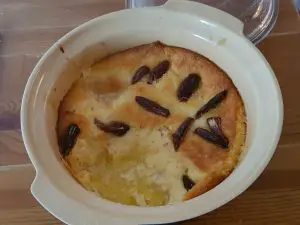Instead of my Claire Chats video this week I have made a "Tudor Cooking with Claire" video. One of my favourite desserts is trifle, so I was drawn to the recipes for "fools" in Tudor cookbooks.
As I explain in the video, the recipe I use is a combination of Gervase Markham's "A Norfolk Fool" and Peter Brears' modern renditions of a Norfolk Fool and "Elizabeth Cromwell's Fool. Here's the recipe I used:
12 thin slices of white bread
6 egg yolks
2 pints/1.2 litres double cream
2 cinnamon sticks
A grating of nutmeg (or a whole nutmeg quartered)
6 dates, sliced
3tbs sugar
sherry
Remove the crusts from the bread. Use four slices of the bread (you can cut the slices into triangles like I did if you like) to line a deep dish.
Pour over enough sherry to soak the bread and let sit for about ten minutes.
Beat the egg yolks with 150ml of the cream.
Heat the remaining cream mixed with the nutmeg, the 2 cinnamon sticks and the sugar. Simmer for 5 minutes. Remove cinnamon sticks (and the quarters of nutmeg if used) and take off the heat.
Cool slightly before beating in the egg yolk and cream mixture.
Pour one-third of the cream over the bread. Top with four slices of bread. Pour on the second third of cream, top with the final four slices of bread. Pour on the remaining cream. Decorate with the date slices.
Let it stand for at least 30 mins and eat cold.
Elizabeth Cromwell (wife of Oliver Cromwell) just used bread to line the dish (soaked in sherry), rather than alternating layers, and Gervase Markham layered the bread but did not soak the bread in sherry. Lady Elinor Fettiplace's version was made by pouring "top of the milk" (Channel Island milk or half milk and half cream) over bread then beating egg yolks into it with sugar, rosewater, a pinch of salt and some sack (use sherry). Currants were then added before baking.
Markham and Cromwell's recipes were not baked, just left for the liquid to soak into the bread to make a "custard". It tasted lovely uncooked, but I also tried baking it (see photo) and that was nice too. I baked it for about an hour in a medium oven.
Gervase Markham's recipe from The English Housewife for "A Norfolk Fool":
Take a pint of the sweetest and thickest cream that can be gotten, and set it on the fire in a very clean scoured skillet, and put into it sugar, cinnamon and nutmeg cut into quarters, and so boil it well: then take the yolks of four eggs, and take off the films, and beat them well with a little sweet cream: then take the four quarters of the nutmeg out of the cream, then put in the eggs, and stir it exceedingly, till it be thick: then take a manchet, and cut it into thin shives, as much as will cover a dish bottom, and holding it in your hand, pour half the cream into the dish: then lay your bread over it, then cover the bread with the rest of the cream, and so let it stand till it be cold: then strew it over with caraway comfits, and prick up some cinnamon comfits, and some sliced dates; or for want thereof, scrape all over it some sugar, and trim the sides of the dish with sugar, and so serve it up.
By the way, today, an English fool is a dessert made by mixing stewed or puréed fruit with cream or custard.
Notes and Sources
- Markham, Gervase (1615), ed. Michael R. Best, The English Housewife, McGill-Queen's University Press, p.102.
- Brears, Peter (2015) Cooking and Dining in Tudor and Early Stuart England, Prospect Books, p.89.
- ed. Spurling, Hilary (1986) Elinor Fettiplace's Receipt Book, Viking Salamander, p.159-160.




Hi, Claire.
I’ve made a Fool for SCA feasts, and they’re always well received.
The only problem I’ve encountered is people who are gluten/egg/dairy intolerant. Then it becomes difficult. Havings said that it is possible by making almond milk from scratch and making it thicker than usual. Gluten-free bread is OK-ish, but the finished product isn’t as nice as the original.
The best fool I’ve made used a day old (stale) brioche, and a wine called White Fontingnac from a local vineyard/winemaker (Rockford from the Barossa Valley). It was a 1997 vintage (!) and was given to me as a gift. Unfortunately, I don’t drink, so it went into the fool. Yum
I was very surprised by Markham’s use of a nutmeg cut into quarters and for a couple of reasons.
Firstly, along with cinnamon sticks and sugar, nutmeg was incredibly expensive spice. So the idea of using a whole nutmeg would have to indicate that the household was wealthy enough to have such a quantity in their spicery.
Secondly, it is possible to overdose on nutmeg.
Nutmeg contains the hallucinogens myristicine and elemicin, and in large enough quantities will cause hallucinations.
Granted, you’d have to use a large amount of fresh nutmeg, ~30-40 grams appears to be the agreed amount.
So, if a particularly large fool was made for a special occasion, eg a wedding, or a royal feast, it is **possible** that the guests may become stoned as well as drunk!
I have heard anecdotal evidence that the effects of a nutmeg high (aka myristicine poisoning) are not particularly nice; the high is nice enough but the crash isn’t so nice.
Anyway, back to the Fool at hand.
A lot of modern recipes for Fruit Fools state the dish dates back as far as the the earliest recipe for a Fool that I’ve found comes from the ‘The Good Huswifes Jewel’ by Thomas Dawson written in 1596:
“Take a pint of thick cream, and season it with sugar and ginger, and
rose water. So stir it as you would then have it make it luke warm in a
dish on a chafing dish and coals. And after put it into a silver piece
or a bowl, and so serve it to the board.”
As you can see, no bread here. I believe that the use of bread or cake was a later addition to the recipe along with seasonal fruits, the most popular being goosberries.
What I want to know, is why is the dish called a Fool?
I’ve tried researching the name a number of times but always come up short.
Anyone ….?
https://erowid.org/plants/nutmeg/
https://erowid.org/psychoactives/faqs/natural_highs_faq.shtml#nutmeg